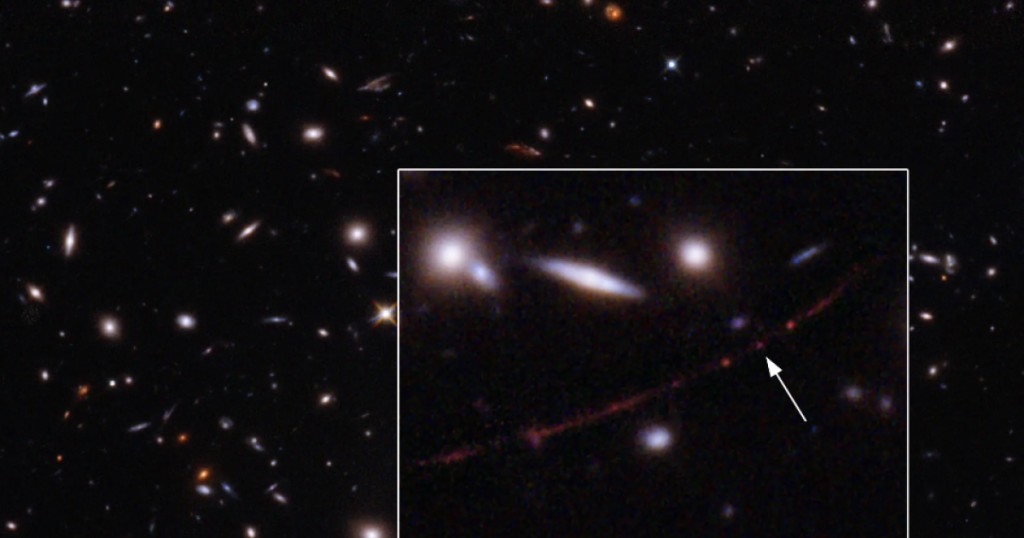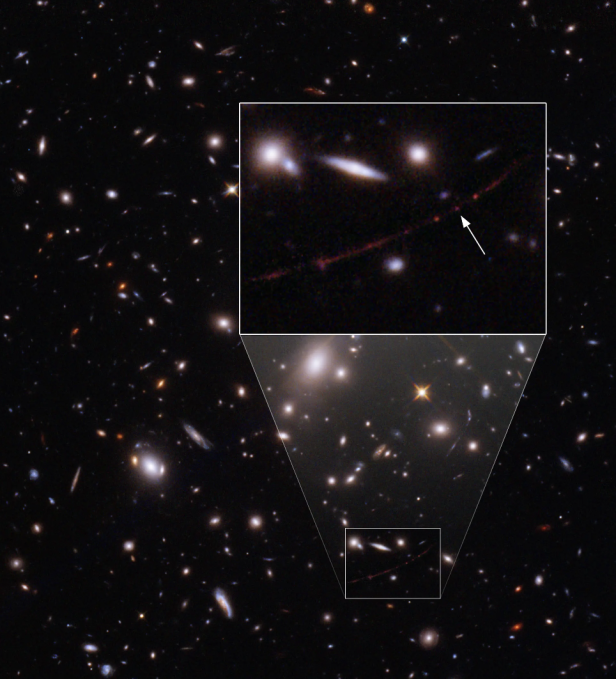© NASA/ESA/Brian Welch JHU et al
The Hubble Space Telescope Take a picture that shows a star at a breathtaking distance. 900 million years after the Big Bang One star shone with the title erendell Bright in a galaxy far, far away. Earendel means “morning star” or “rising light” in Old English.
Not much can be seen in the Hubble image. You only see a faint spot on the crescent light. However, recording is something very special and of great importance. Because it is a miracle that the star is visible at all. just this gravitational lens Thanks, because in reality such old stars can no longer be observed individually because they are too faint.
This is how the star was picked up
Using the so-called gravitational lensing effect, the light was amplified due to the presence of a huge body between the observer and the celestial body. So in this particular case, there was a large group of galaxies in the line of sight, where the gravitational pull of this mass of matter bends the light from distant objects behind and thus enlarges it. This is how Earndel became visible because he was in the “sweet spot” of gravitational lenses.
“We were lucky. This is really extreme. It is really exciting to find something this big.” Brian WelchPostgraduate student in Johns Hopkins University in Maryland (USA) BBC. In this case, the sweet spot hit by chance.
Earendel is where the arrow is pointing – you can only see a small spot
© NASA/ESA/Brian Welch JHU et al
The previous record holder was Icarus
The farthest star seen in front of the lens was Icarus. was at a distance from 9 billion Observed light driving. Earndale is much more than that. The star is round at a distance 12.9 billion Light year new record holder. According to Welch, Earendel could have been a star in a single or binary system. It’s unclear how big Earendel might be. star at least 50 times heavier than our sunbut depending on the exact magnification, the star could be much larger.
According to researchers, it could also be a theoretical one pioneer star They act, but they are not sure. This would be an object made of pure gas formed in the Big Bang. The first stars in the universe consisted only of hydrogen and helium. Only the later stars merged with the heavier elements.
So, if it was really a leading star, it would have grown from a completely isolated and unpolluted gas cloud to survive long enough to be seen now. “We expect Earndale to be a star that is more enriched with fewer heavy elements,” Welch said.
More detailed research is possible
with the James Webb Telescope, Hubble’s successor, argues that such developments can be more accurately understood. James Webb will be able to elicit details beyond Hubble. The new telescope will begin full scientific operation in two or three months.

“Social media evangelist. Baconaholic. Devoted reader. Twitter scholar. Avid coffee trailblazer.”








More Stories
Ubisoft wants to release a new Assassin's Creed game every 6 months!
A horror game from former developers at Rockstar
Turtle Beach offers the Stealth Pivot Controller for PC and Xbox